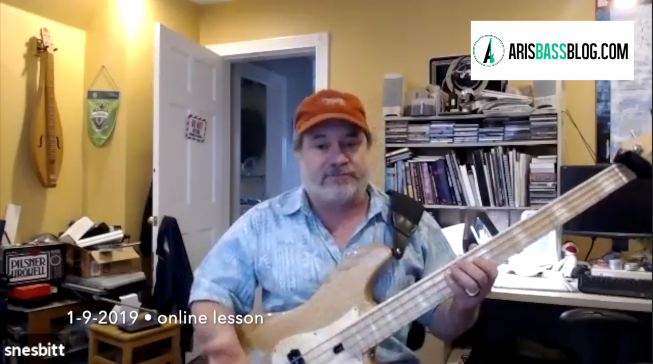Take it from my student Stephen:
This is how you know… that you know modes!
My student Steve was kind enough to let me post this from a recent lesson. This is him presenting a homework assignment on modes. And as he was doing that I asked him to turn into the teacher.
When we first started out working on modes, Steve, like many, was quite lost. He had heard a bit about C ionian, D dorian E phrygian etc., but how they really sounded, and how to build them in all keys and in all areas of the bass was a total mystery.
Just a few weeks prior to this video, Steve was convinced there was absolutely no way he could wrap his mind around this modes thing, let alone playing them in all positions on the bass.
And now, just a few short weeks later, here he is, demonstrating beautifully his comprehensive knowledge of the modes all over the fretboard! To test this, I had him stay in one position on the bass, and not jump around (an additional layer of difficulty)!
This is literally everything you need to know to create all seven modes on the bass, anywhere on the fretboard!
Note: When Steve talks about P1, P2 etc, he means “Pattern 1”, “Pattern 2” etc. Watch and then read the synopsis and notes below!
The keys to really understanding and being able to USE modes:
- Steve is starting from the same root (not: C major, D dorian, E phrygian! That way you cannot hear the quality of the modes and you wan’t be able to create them in all keys). Instead, he starts all of them from the same root: F ionian, F dorian etc.
- He plays the mode from the root all the way up in that position, turns around, and plays them all the way down in that position and back to the root. This ensures he knows all the notes of that mode in that area of the bass while at the same time hearing the quality of the mode as it relates it to the relevant starting note, F! I love how he demonstrates his complete understanding of the modes by:
- Effectively pointing out the sound quality of each mode!
- Explaining the theory of the mode in terms of scale degrees!
- Identifying the “mother scale” (ie the scale this mode shares the key signature with).
In addition, Steve matches up the modes up with the relevant pattern of the Pattern System. (Keep your eyes on the blog for announcements on the new Pattern System program and book. To make sure you don’t miss an announcement, put your name here and stay on the blog.)
Well done, Steve!
Worth mentioning that Steve has not been playing very long at all and only been a student of mine since September 2017. Discipline, Courage, and an Open Mind – The “secret” ingredients for success. Steve clearly has them. Leave him some props in the comments, y’all! Steve plays guitar and bass. He lives in Seattle and is in the process of building a website called makingbettermusic.com Please support!
Now that you know how to build them – Thank you Steve! – you are ready to explore their multi-faceted uses. There are SO many!
We can certainly use them in modal music but equally as well in diatonic music and in what’s called “mixed modal” music. Stay tuned for more!
You got this, folks. Learn theory – it enhances the magic!
More on Modes
The ultimate shortcut to modes
To Study with Ari
At the moment of this writing I have a quite substantial waiting list; You can add yourself to Ari’s waiting list here.
To start right now, explore Ari’s Music Theory course.





